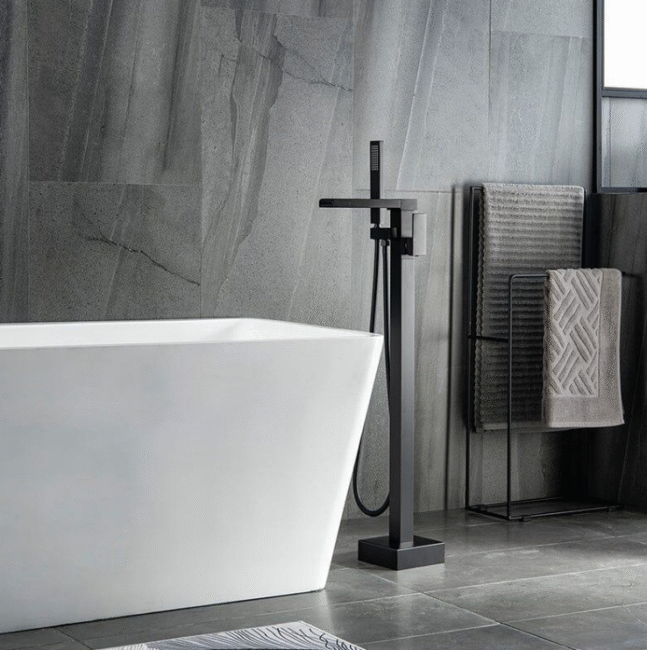A freestanding bathtub faucet is not just a functional element—it’s a design statement. It adds elegance, minimalism, and modernity to any bathroom space. However, installing one is not as straightforward as it may seem. From plumbing access to compatibility and mounting details, every step matters. This article outlines key considerations and common mistakes to avoid when installing a freestanding bathtub faucet, ensuring a seamless and lasting result.
Key Installation Considerations

1. Plumbing Access
Before choosing or installing a freestanding faucet, you must ensure your bathroom’s plumbing system can support it. Freestanding faucets require specific floor-mounted water supply lines, which should ideally be planned during the initial bathroom layout. If the faucet was not pre-planned, retrofitting plumbing lines after the fact can be time-consuming, expensive, and invasive to existing structures. Pre-planning your plumbing needs for all fixtures—especially floor-mounted ones—can save you from significant headaches later.
2. Faucet and Bathtub Compatibility
Freestanding bathtubs and their faucets are independent components, so it’s possible to end up with mismatched parts. Ensure the faucet height, spout reach, and style are compatible with the bathtub you’ve selected. A faucet that’s too short or has an awkward angle might lead to poor functionality or water spillage. It’s always wise to buy the faucet and bathtub from a supplier who understands how to match them properly.
3. Proper Mounting
The structural stability of freestanding faucets depends heavily on how well they’re mounted. A loosely mounted faucet may wobble, leak, or even detach from the floor over time. Follow the manufacturer’s mounting instructions closely. Ensure the base is tightly secured, ideally anchored to a subfloor or stabilizing bracket beneath the tiles. Using the right mounting flange and hardware is essential to long-term performance and safety.
4. Faucet Height and Adjustability
Freestanding faucets should always rise higher than the bathtub’s edge. Some designs offer adjustable heights, but many do not. Be sure the faucet can deliver water into the tub without obstruction. This isn’t just about aesthetics—practicality is key. A faucet that’s too low will be inefficient at filling the tub and may splash water over the edges.
Common Mistakes to Avoid During Installation
Skipping Preparation Steps
A successful installation starts with proper preparation. Always shut off the water supply and clean all surfaces before beginning. Skipping basic prep can result in leaks, poor adhesive bonding, and installation delays. Taking time to prepare ensures a smoother, safer, and more professional installation process.
Ignoring Component Compatibility
One of the biggest installation pitfalls is using mismatched parts. When choosing couplers, extension pipes, connectors, or valve fittings, double-check thread types, sizes, and materials. Even minor mismatches can result in leaks or system failure. A professional plumber or trusted supplier can help confirm compatibility if you’re unsure.
Failing to Test for Leaks
Never assume your installation is complete until you’ve thoroughly checked for leaks. Run water through the system and inspect every connection, especially if you’ve extended or modified plumbing lines. Fixing a leak after you’ve closed up flooring or wall cavities is far more costly and damaging. Early detection saves money, effort, and potential water damage to your home.
Applying Insufficient Sealant
Sealant is your first line of defense against water leaks. Apply it generously around joints, connectors, and base fixtures. Avoid applying too little, especially in areas where water pressure might build over time. Use high-quality plumbing sealant or silicone caulk designed specifically for bathroom applications.
Over-Tightening or Under-Tightening
Over-tightening fittings can crack or strip components—especially in plastic or softer metal fixtures—while under-tightening can lead to loose connections and leaks. Always follow the manufacturer’s torque recommendations if provided. If you’re unsure, hand-tighten fittings first, then use a tool to give a slight additional turn without forcing it.
Thinking of Renovating Your Bathroom?
If you’re planning to renovate or upgrade your bathroom, Giving Tree Home is your trusted partner. Whether you’re seeking an individual freestanding faucet, a beautifully designed bathtub, or a fully coordinated set of bathroom furnishings, Giving Tree Home offers a wide range of high-quality products designed for seamless integration. Their collections are curated not just for performance, but for style and cohesion—helping you create a unified, elegant bathroom with ease.
